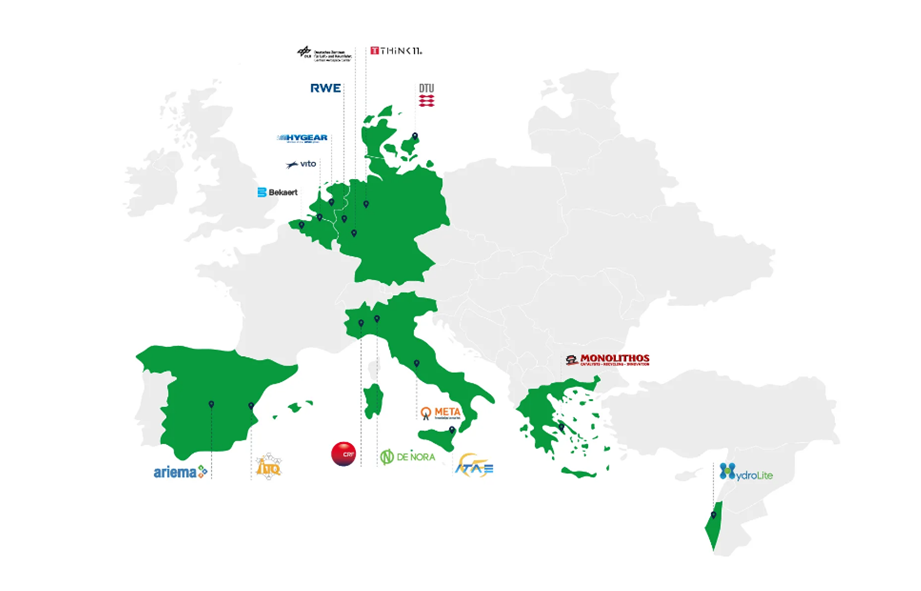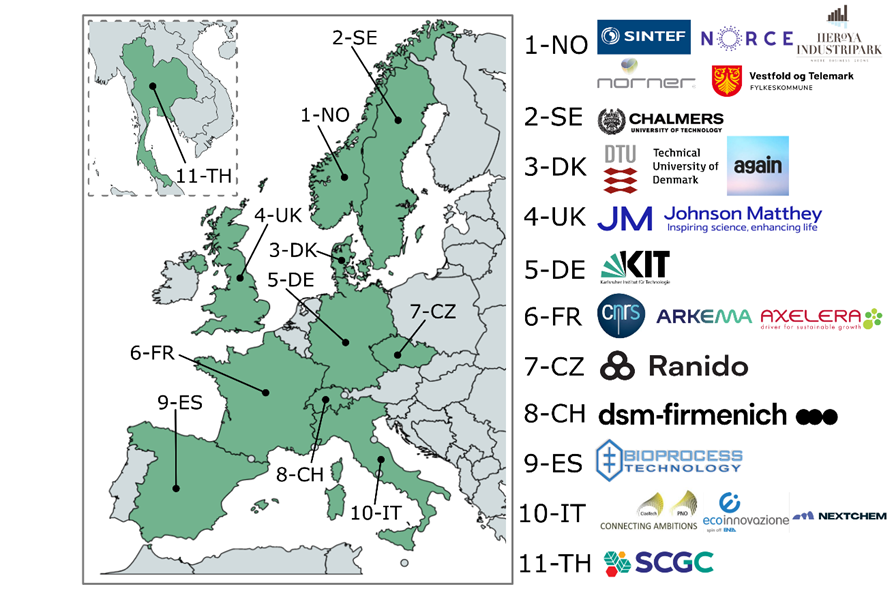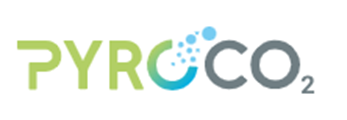Details
- Publication date
- Source
- Green Deal Projects Support Office
Carbon capture and utilisation (CCU) is establishing itself as a crucial player in the decarbonisation efforts across diverse industries, spanning from power generation to the energy intensive industrial sectors. Functioning as a bridge during the transition from conventional fossil fuels to renewable energy sources, CCU provides a practical solution for supporting climate change objectives while ensuring energy security. In the race against time to achieve sustainable energy solutions by 2050, understanding the multifaceted significance of CCU is pivotal for effectively navigating our way through the terrain of climate action.
What is CCUS, CCU and CCS?
Within the broader context, Carbon Capture, Utilisation, and Storage (CCUS) is a technology that encompasses various applications where CO₂ is captured and then either compressed and transported to be injected into deep geological formations (CCS) or used in a range of different applications (CCU) (See figure 1). Presently, captured CO₂ is mainly used to produce fertiliser but there is growing momentum in new applications such as CO₂-based synthetic chemicals, fuels and building aggregates in the cement industry. The intensity of CO₂ utilisation emission reduction and the climate benefits depend on factors such as the source of energy, the replaced product, the energy's carbon intensity during conversion, and the product’s life-time.
CCUS can offer significant climate benefits – such as in reducing emissions in “hard-to-abate” industries – it is evident that the current market size remains relatively small. Significant investments will be required to build the market up, with the Commission estimating deployment costs of approximately EUR 12.2 billion by 2030. Going forward, the primary focus should therefore be on dedicated storage, which offers the most cost-effective option in several regions for deep decarbonisation. Nevertheless, the support from research, development, and demonstration efforts can accelerate the deployment of scalable CO₂-derived products and services.
Tracking the landscape of CCU, current applications encompass both direct and indirect usage of captured CO₂ in various products. Globally, approximately 230 million tonnes of CO₂ are currently used annually, primarily in the fertiliser sector for urea production (~130 million tonnes) and enhanced oil recovery (~80 million tonnes). However, more utilisation pathways are emerging, especially in CO₂-based synthetic fuels, chemicals, and building aggregates.

CCU in the EU
The EU's journey in developing and implementing CCU policies is rooted in its commitment to ambitious climate targets. Over the years, the EU has taken significant strides to promote the deployment of CCU technologies through a comprehensive policy landscape shaped by key initiatives. This includes the adoption of the EU Green Deal, the Climate Law, and subsequent proposals to elevate energy and climate targets for 2030.
In December 2021, the Commission's Communication on Sustainable Carbon Cycles outlined key actions supporting industrial capture, use, and storage of CO₂, including a thorough assessment of cross-border CO₂ infrastructure deployment needs until 2030 and beyond. Subsequent initiatives, such as the proposal for an EU-wide voluntary framework for certifying carbon removals, aim to boost innovative industrial carbon removal technologies, including bioenergy with carbon capture and storage and direct air carbon capture and storage.
Below are a few notable avenues through which the EU supports the deployment of CCU technology:
- November 2021: In the first call for large-scale projects, four out of the seven awarded featured aspects of CCUS.
- July 11, 2022: The second large-scale call communicated their results, and seven out of 17 projects featured CCUS technology.
- November 2022: The Commission doubled funding for the third large-scale call to around EUR 3 billion to boost industrial decarbonisation in Europe.
- March 16, 2023: The third large-scale call closed after receiving 239 applications
- March 30, 2023: The third call for small-scale projects with a EUR 100 million budget was launched, open to EU countries, Iceland, and Norway, with eligibility for projects including CCS and CCU technology.
- November 23, 2023: Commission revealed the Innovation Fund 2023, earmarking EUR 4.8 billion to drive innovation in cleantech. This call invites projects in sectors like decarbonisation, cleantech manufacturing, and more.
- Horizon Europe Cluster 5 (Climate, Energy, and Mobility): Supports the development and improvement of CO₂ capture technologies.
- Dedicated project CCUS Zero Emission Network (ZEN): Sitting under Cluster 5, it supports the integration of CCS and CCU in hubs and industry clusters .
- Horizon Europe Cluster 4 (Digital, Industry, and Space): Several calls address CCU in topics related to industrial symbiosis and Hubs for Circularity (self-sustaining economic industrial ecosystems).
State Aid:
The Commission enables EU countries to support CCUS technology through State Aid under specific conditions.
Carbon capture projects funded by the EU Green Deal Call
In the realm of the EU’s CCU landscape, the ECO2Fuel Project stands out with a distinct mission. The project sets out to design, manufacture, operate, and validate the world's inaugural 1MW low-temperature electrochemical CO₂ conversion system, with the ultimate goal of producing economic and sustainable e-fuels and chemicals. This ambitious endeavour involves collaborating with 15 international partners spanning the chemical, energy, hydrogen, mechanical engineering, and automotive industries, together with several research institutions.
Together, they aim to pioneer the first-ever CO₂ conversion system capable of transforming 742 tons of CO₂ annually into economically viable and sustainable liquid e-fuels and chemicals. At the heart of the ECO2Fuel system is a revolutionary electrocatalytic conversion process, which is carried out at low temperatures using water and renewable electricity.
As with the development of any innovative technology, the ECO2Fuel project is faced with challenges and continually working on improvements, e.g. to optimise the efficiency of the conversion process and to ensure the stability and scalability of the system to make it suitable for industrial applications.
As ECO2Fuel forges ahead, it exemplifies a paradigm shift in CCU technologies, taking us on a course toward a more sustainable and resilient energy system in the European Union.

The main objective of the PYROCO2 project is the engineering, construction, and operation of a large-scale demonstrator plant, designed to validate the scalability and economic viability of CCU technology using an innovative biotechnological process. This initiative aims to produce climate-positive acetone by converting up to 10,000 tonnes of industrial CO₂ annually into a range of value-added products, using renewable electricity-derived hydrogen.
The estimated 1.4 million tonnes of acetone produced in Europe annually releases around 2.3 million tonnes of CO₂ equivalents. The project's ambition is to demonstrate a significant reduction in emissions, targeting savings of 17 million tonnes of CO₂ equivalents by 2050 , thereby contributing to the European Green Deal's objectives.
The PYROCO2 process centres around an energy-efficient process that uses bacteria to convert CO₂ into acetone, which not only underscores the project's innovative approach to CCU but also its potential to revolutionise the production of chemicals and materials with a lower carbon footprint. By generating acetone, a key commodity in the chemical industry, PYROCO2 lays the groundwork to create a wide array of chemicals, synthetic fuels, and recyclable polymers, all derived from CO₂. This positions PYROCO2 as a pioneering force in the CCU domain, offering a suite of viable business cases and processes that can be replicated and commercialised in the future.
Strategically located at the Herøya Industrial Park in southern Norway, the PYROCO2 demonstrator plant benefits from access to abundant industrial CO₂ feedstock and competitively priced green energy. This strategic choice not only facilitates the project's industrial symbiosis approach but also strengthens the link between carbon-intensive industries and sustainable chemical production, promoting a comprehensive carbon capture and utilisation strategy.
The PYROCO2 project stands as a testament to the collaborative effort across the EU's CCUS ecosystem, involving a consortium of 20 partners from ten European countries and extending its outreach to the Asian market. With a budget of nearly EUR 44 million, funded by the European Union’s Horizon 2020 research and innovation program, PYROCO2 is set to achieve significant milestones. By 2026, the project aims to establish its large-scale demonstrator. By highlighting the practicality, flexibility, and cost-effectiveness of its biotechnological production platform, it will help the EU's chemical industry in its transition towards climate neutrality.
In summary, PYROCO2's advancements in CCU technology are poised to make a lasting impact on the European chemical production landscape, driving the development of CCU Hubs across Europe and fostering the adoption of climate-positive solutions. Through rigorous demonstrations, comprehensive assessments, and the exploration of market potential, PYROCO2 is shaping the future of sustainable and resilient chemical production in Europe.
Figure 2 Map of PYROCO2 international partners

Conclusion
CCU is emerging as a crucial set of technologies in shifting our reliance from fossil fuels to renewable sources. The EU demonstrates a commitment to ambitious climate targets through comprehensive policies and initiatives to propel the development and deployment of CCU. In this article we looked at two exemplary projects funded by the EU Green Deal Call, ECO2fuel and PYROCO2. They demonstrate the tangible impact of innovation in the CCU landscape, with the EU positioned at the forefront of a resilient energy transition. Through collaborative efforts, these projects exemplify the transformative potential of CCU technologies in mitigating climate change and ensuring a greener tomorrow.



